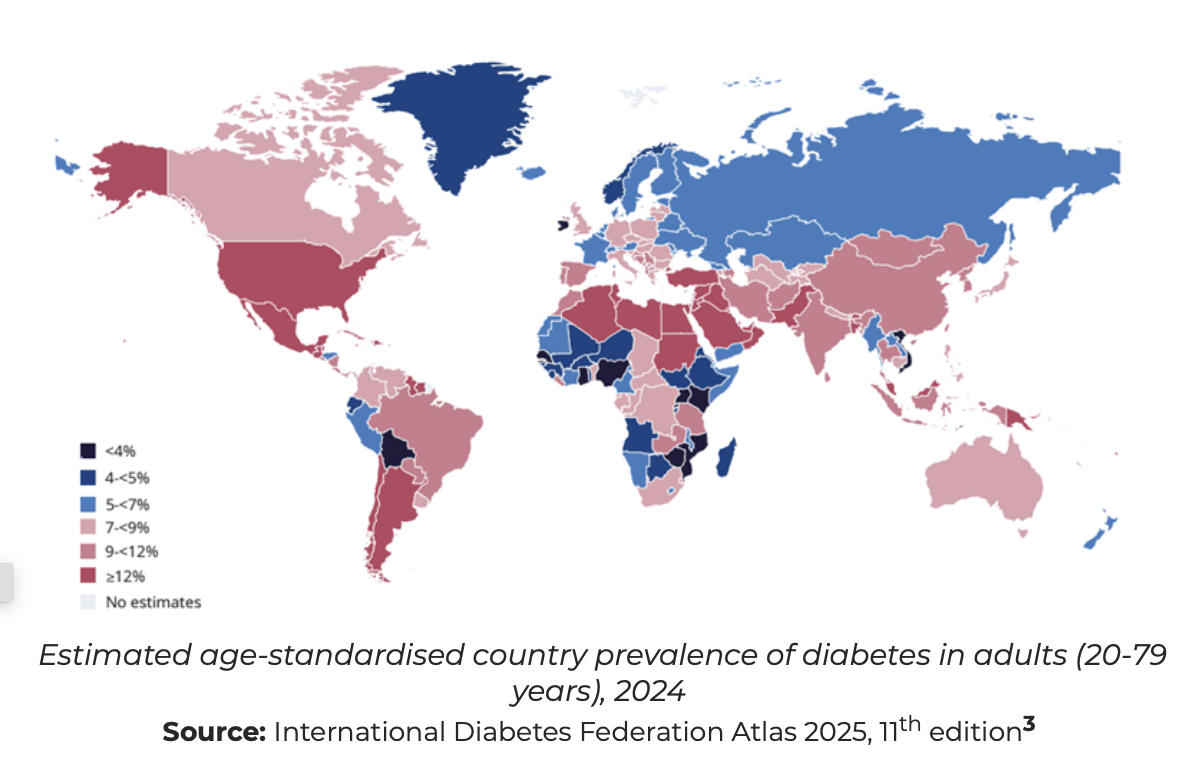The number of adults living with diabetes has more than doubled over the span of 30 years, rising from 7% in 1990 to more than 14% in 2022.1 An estimated 828 million adults worldwide currently live with diabetes, and if trends continue, this is projected to reach 1.3 billion by 2050.2

Diabetes is a chronic disease that occurs when the body is unable to produce enough insulin – a hormone which regulates blood sugar – or unable to efficiently use the insulin it produces. This condition leads to high blood sugar levels, which, if left untreated, can result in severe health complications such as blindness, nerve damage, heart disease, kidney failure, and obesity.4 Early intervention, including lifestyle and dietary changes, can help prevent and manage diabetes effectively.
Why Should Employers Care?
The surge in diabetes extends far beyond public health concerns, significantly impacting business performance and economic stability. Alongside the direct costs related to diabetes care and treatment, the hidden indirect costs, such as lost productivity, absenteeism, and presenteeism, place a heavy economic burden on businesses across all sectors.5 In the United States, where 11% of the population is affected by diabetes, the annual cost of diagnosed diabetes reaches up to $250 billion, with $70 billion attributed to indirect costs such as lost productivity.6
The economic burden is even more pronounced in low- and middle-income countries, where over 80% of people with diabetes reside.7 Limited access to healthy food, delayed diagnosis, reduced access to healthcare services, and inadequate management exacerbates the prevalence of diabetes among vulnerable populations. In India, which has the world's highest number of adults with diabetes, the direct cost per person amounts to approximately US$227, while indirect costs total around US$218 per person annually.8

Diabetes Management at the Workplace
Employers play a critical role in addressing diabetes through proactive measures that support employee health and well-being. A 2017 meta-analysis study published in the Journal of Occupational Health9 found that workplace dietary interventions can effectively lower blood sugar levels. The most effective workplace programs take a multi-component approach, combining dietary modifications, increased physical activity, and well-being initiatives such as stress management and smoking cessation.1011 Without such interventions, employees with diabetes lose an average of 4.2 more workdays annually than those without diabetes, impacting their productivity and efficiency.12
"Innovative programs that support workers in managing chronic diseases like diabetes are needed to help address issues like low productivity, high worker turnover, and the increasing health care and disability costs associated with worker health problems."
_McCarthy, M. et al. (2021) ‘Managing Diabetes in the Workplace’, Workplace Health & Safety, 69(5), pp. 216–223. doi:10.1177/2165079920965538.

What can Employers do?
The evidence for diabetes management strategies at the workplace suggests practical steps that employers can take to improve the health of their employees and reduce the burden of diabetes. This includes:
Personalised Nutrition Plans
- Provide employees with personalised nutrition plans which consider individual dietary preferences, cultural considerations, and medical requirements to create sustainable and effective meal strategies.
Collaborate with registered dietitians or nutritionists to offer one-on-one consultations, helping employees make informed food choices that regulate blood sugar levels.
Behavioral Support (Counselling and Self-Monitoring)
- Offer behavioral support programs, such as peer support groups and psychological counselling to create a safe environment to manage diabetes effectively.
- Provide access to and training to use self-monitoring tools, such as glucose tracking and health measurement apps.
Nutrition Education and Nudging
- Give workshops and information materials to raise awareness on the importance of diet in managing diabetes.
- Nudge employees to eat healthier, by placing healthy snacks in visible locations and promoting their benefits through posters and communication channels.
Reduced Calorie and Healthy Diets at the Workplace
Offer healthy food options at the workplace, such as food with high-fiber and healthy fats, and low in sugar and processed, to promote healthier eating habits among employees.
Take Action: Implement Workforce Nutrition Programme
With diabetes rates rising worldwide, employers have a unique opportunity to drive change by fostering a healthier workforce. Implementing a Workforce Nutrition Programme can help prevent and manage diabetes among employees, leading to increased productivity, reduced healthcare costs, and improved overall well-being. Workforce Nutrition initiatives empower businesses to create a supportive environment through tailored nutrition interventions, education, and access to healthier food choices at work.
The Workforce Nutrition Alliance provides businesses with the tools and resources needed to establish impactful nutrition programs at workplaces. Their initiatives focus on ensuring access to healthy meals, nutrition education, nutrition health checks and breastfeeding support.
Learn more about how the Workforce Nutrition Programme can contribute to a healthier, more productive workplace by visiting Workforce Nutrition Alliance.
References:
Breton, Marie-Claude, Line Guénette, Mohamed Amine Amiche, Jeanne-Françoise Kayibanda, Jean-Pierre Grégoire, and Jocelyne Moisan. 2013. “Burden of Diabetes on the Ability to Work.” Diabetes Care 36 (3): 740–49. https://doi.org/10.2337/dc12-0354.
Butt, Muhammad Daoud, Siew Chin Ong, Azra Rafiq, Muhammad Nasir Kalam, Ahsan Sajjad, Muhammad Abdullah, Tooba Malik, Fatima Yaseen, and Zaheer-Ud-Din Babar. 2024. “A Systematic Review of the Economic Burden of Diabetes Mellitus: Contrasting Perspectives From High and Low Middle-income Countries.” Journal of Pharmaceutical Policy and Practice 17 (1). https://doi.org/10.1080/20523211.2024.2322107.
Hafez, Dina, Allison Fedewa, Margaret Moran, Matthew O’Brien, Ronald Ackermann, and Jeffrey T. Kullgren. 2017. “Workplace Interventions to Prevent Type 2 Diabetes Mellitus: A Narrative Review.” Current Diabetes Reports 17 (2). https://doi.org/10.1007/s11892-017-0840-0.
International Diabetes Federation. 2023. “New Estimates Indicate That More Than 1.3 Billion People Could Be Living With Diabetes by 2050 - International Diabetes Federation.” June 26, 2023. https://idf.org/news/gbd-estimates-2021/.
McCarthy, Margaret, Allison Vorderstrasse, Joeyee Yan, Angie Portillo, and Victoria Vaughan Dickson. 2020. “Managing Diabetes in the Workplace.” Workplace Health & Safety 69 (5): 216–23. https://doi.org/10.1177/2165079920965538.
Oberoi, Sumit, and Pooja Kansra. 2020. “Economic Menace of Diabetes in India: A Systematic Review.” International Journal of Diabetes in Developing Countries 40 (4): 464–75. https://doi.org/10.1007/s13410-020-00838-z.
Park, Joohyun, Elizabeth Bigman, and Ping Zhang. 2022. “Productivity Loss and Medical Costs Associated With Type 2 Diabetes Among Employees Aged 18–64 Years With Large Employer-Sponsored Insurance.” Diabetes Care 45 (11): 2553–60. https://doi.org/10.2337/dc22-0445.
Ritchie, Natalie D, Katherine Jw Baucom, and Katherine A Sauder. 2020. “Current Perspectives on the Impact of the National Diabetes Prevention Program: Building on Successes and Overcoming Challenges.” Diabetes Metabolic Syndrome and Obesity 13 (August): 2949–57. https://doi.org/10.2147/dmso.s218334.
Shrestha, Archana, Biraj Man Karmacharya, Polyna Khudyakov, Mary Beth Weber, and Donna Spiegelman. 2017. “Dietary Interventions to Prevent and Manage Diabetes in Worksite Settings: A Meta‐analysis.” Journal of Occupational Health 60 (1): 31–45. https://doi.org/10.1539/joh.17-0121-ra.
Tabano, David C., Melissa L. Anderson, Debra P. Ritzwoller, Arne Beck, Nikki Carroll, Paul A. Fishman, and David C. Grossman. 2018. “Estimating the Impact of Diabetes Mellitus on Worker Productivity Using Self-Report, Electronic Health Record and Human Resource Data.” Journal of Occupational and Environmental Medicine 60 (11): e569–74. https://doi.org/10.1097/jom.0000000000001441.
World Health Organization. 2024. “Diabetes.” WHO. November 14, 2024. https://www.who.int/news-room/fact-sheets/detail/diabetes#:~:text=Over%20time%2C%20diabetes%20can%20damage,attack%2C%20stroke%20and%20kidney%20failure.
Zhou, Bin, Archie W Rayner, Edward W Gregg, Kate E Sheffer, Rodrigo M Carrillo-Larco, James E Bennett, Jonathan E Shaw, et al. 2024. “Worldwide Trends in Diabetes Prevalence and Treatment From 1990 to 2022: A Pooled Analysis of 1108 Population-representative Studies With 141 Million Participants.” The Lancet 404 (10467): 2077–93. https://doi.org/10.1016/s0140-6736(24)02317-1.